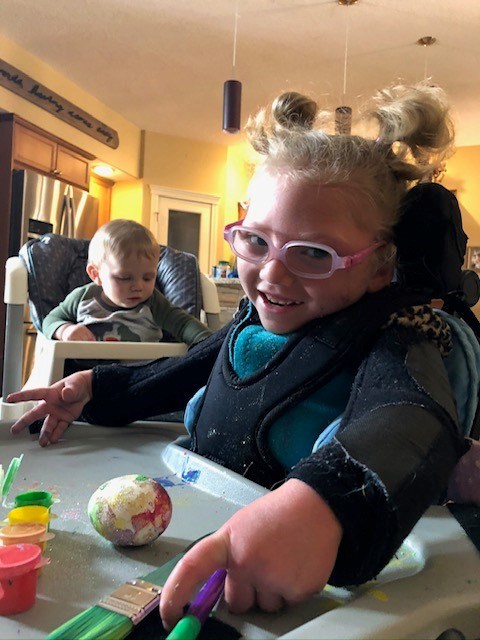An Okotoks mom hopes to continue a special treatment for her daughter this summer after COVID threw a wrench in therapy plans.
Stephanie Sonnenberg took daughter Claire to Arizona last January for her first stem cell treatment for cerebral palsy, and she was signed on for a trial to do a booster three months later followed by additional stem cell treatments every six months.
The booster would have been during the time of the shutdown last spring, and never happened because of the pandemic. Since that time, they’ve had to cancel four appointments.
“It’s bad – you want to continue the progress,” said Sonnenberg. “It’s hurt her. It’s not that she’s regressed, but the progress she had been making has been put on hold.”
She said the gains Claire made last year were more on the cognitive side, though she did show some physical improvement as well.
Going into the treatment, nobody knew what to expect because children react to the therapy differently.
Sonnenberg said she was thrilled to see Claire was able to actively communicate more with the help of a special eye gaze device.
“She can’t talk to us yet, she’s only playing games right now, but she can use her eyes to perform functions on a device,” she said. "Claire looked at things but she was never able to show us that she understood what we were telling her. Now, we can tell her to do something and she will do it.”
For instance, if asked to find a cat or character on her screen, or press pause on a video, she can perform those tasks with her eyes.
It’s a far cry from before, when Claire would do whatever she wanted with her device, which she operated with switches at the time, and showed no indication she understood the directions being given to her.
“Now she’s kind of showing us she can do what we say,” said Sonnenberg, “It opens a million doors for her now that she can actively communicate.
“It’s the most important thing in the world for us, to have her be able to talk to us and tell us what she wants and what she doesn’t want.”
On the physical side, there have been some fairly major changes.
Like many children with cerebral palsy, Claire had held her hands in tight fists. Now, her fingers are more open and she’s able to grip things like crayons or scissors.
“She loves art – we never knew that,” said Sonnenberg. “She loves to draw and colour at school with her friends. She’s really crafty.”
In addition, Claire was able to walk a little better when they first returned from Arizona with the help of intensive therapies including two weeks in Edmonton with a specialized team.
“Her walking got amazing in her walker,” said Sonnenberg. “She, for the first time ever, got her walker across the floor without us helping her push the weight of it.”
It’s disappointing they haven’t been able to continue the stem cell treatments as scheduled, said Sonnenberg.
According to research, the stem cells will work for about six months before they are incorporated into the brain and another treatment is needed to keep the progress going, she said.
They also work best when children are younger, because the brain is still developing and can be affected by introducing stem cells.
Claire just turned five this month, and Sonnenberg is worried they’re losing time. She hopes to get back to Arizona this summer, after cancelling another appointment that had been scheduled for March 2.
“We’ll go until it’s stopped doing something for her,” she said. “I think she’ll let us know when it’s time to stop.”
She said it’s not just being unable to travel and quarantine for additional stem cell treatment that’s taking its toll.
Here at home, most of Claire’s regular therapies were cancelled and closed during the spring and some still have not picked back up.
“If you go to stem cells and then come back and you can’t get into the centres for the intensive therapy, then it’s kind of a lose-lose,” said Sonnenberg.
It affects more than the effectiveness of the stem cells, she said. For children like Claire, and their families, COVID-19 has been very difficult – especially with therapy being cancelled or moved online.
“Zoom for school I can understand, but for kids who need hands-on, at least two people to get them walking in a walker or to do the stretches they need to help them stand, all of that was cancelled and it was really hard on us,” said Sonnenberg. “We just do what we can.”
Claire has an aide who visits Monday through Friday for three hours of therapy every morning, and a school she attends for some therapy has also opened but only on a one-on-one basis.
Sonnenberg said it’s hard when only one person is allowed to work with Claire, because she missed out on a lot of hands-on work with walking and other activities that require three people to support her arms and legs.
“I understand the whys with COVID, it’s just for these kids who need it, it’s definitely not what it used to be,” said Sonnenberg.




